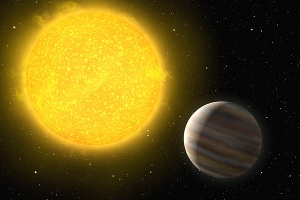Research programme
Exo-planets, star and planet formation
At Leiden Observatory, researchers investigate the origin of stars and their planetary systems. They detect and characterize planets around other stars, which are called exo-planets. They study how stars and planets form. And they follow molecules from interstellar clouds to nascent planet systems. This way they address questions about life’s origin and planetary habitability. In other words, is Earth unique?
- Contact
- Ignas Snellen

Throughout the Milky Way, clouds of gas and dust produce stars and planets. Recent searches for planets around other stars indicate that planet systems are the norm rather than the exception, with new systems discovered every day. Leiden astronomers seek answers to fundamental questions about exoplanets and how they form. How many Earth-like planets exist? Do they have atmospheres? What physics plays a role in the formation of stars? How do planets grow from disks of gas and dust around young stars? What is the chemistry of interstellar material on its voyage from clouds to forming stars and ultimately to newborn planets? What is the inventory of organics and water in regions of planet formation, particularly in the habitable zone? What does the composition of Earth and Solar System objects tell us about how they formed? At Leiden Observatory these questions are addressed through a powerful combination of astronomical observations, theory and simulation of the relevant physics and chemistry, and laboratory experiments that simulate space.
Staff members at Leiden Observatory address these topics within their research programs and collaborations. They study the physics and chemistry of the interstellar medium – including gas, dust, ice, and Polycyclic Aromatic Hydrocarbons –, examine forming stars and planets, detect and characterize exoplanets, and simulate the dynamics of stellar clusters and how this affects the way planets form. They have access to the world’s most powerful telescopes, such as VLT and ALMA, and upcoming facilities such as the E-ELT and JWST. Instrumentation development at Leiden Observatory provides key technologies enabling breakthrough observations with these facilities. Spectroscopy and high-contrast imaging across the electro-magnetic spectrum are analyzed using staff expertise on stellar properties and molecular astrophysics. Theoretical and computational efforts range from gravitational dynamics to radiation transfer and quantum chemistry. Work at the Raymond & Beverly Sackler Laboratory for Astrophysics explores experimental approaches. At Leiden Observatory, astronomy, physics and chemistry come together in an effort to identify planet systems in the Galaxy, characterize them, find out how they form, and place Earth in this framework.
